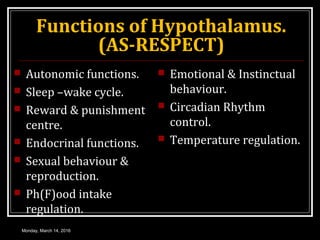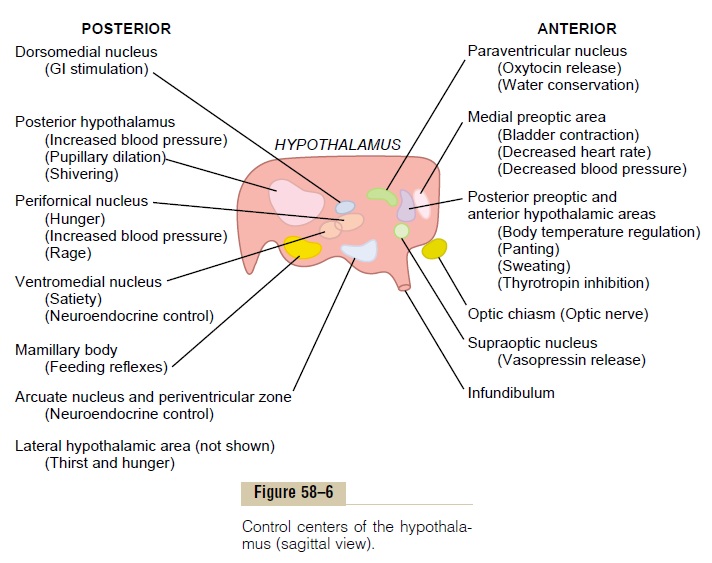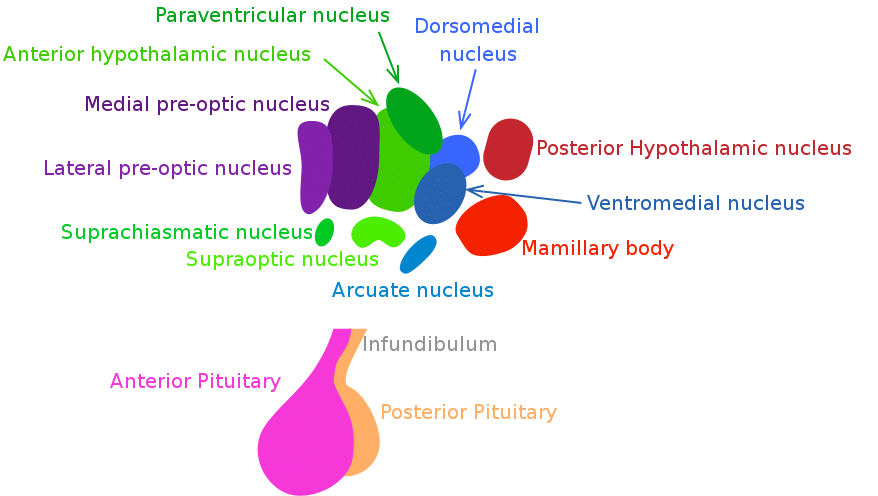Describe the Functions of the Hypothalamus
Predict the effects that an injury stroke ischemia virus etc in the hypothalamus would have on the bodys ability to maintain homeostasis. The key function of the hypothalamus is to produce hormones that keep the body in a stable condition called homeostasis.

Hypothalamic Physiological Function The Hypothalamus Plays A Role In Download Scientific Diagram
Nerve cells in the brain are organized in different fashions depending on location.

. It regulates heart rate respiration blood pressure BP body temperature water and electrolyte balance. Thus when the hypothalamus doesnt work properly it can cause organic problems that can lead to many disorders. List and describe 4 of the 8 functions of the hypothalamus.
The hypothalamus is located in the diencephalon region of the forebrain directs a number of needed functions in the body and is the control center for several autonomic functions. On the other hand although hypothalamic diseases. The hypothalamus in the brain contains the temperature monitoring centre for the body.
The visceral brain describes a set of structures within the forebrain including the amygdala and hippocampus also referred to as the. The main function of the hypothalamus is to maintain the homeostasis of the body. List and describe 4 of the 8 functions of the hypothalamus.
At the autonomic level the hypothalamus stimulates smooth muscle which lines the blood vessels stomach and intestines and receives sensory impulses from these areas. O connected by blood flow in hypophysial portal system hypothalamic hormones hypothalamus is coordinating center of brain for. HYPOTHALAMUS The important function of hypothalamus is to link the nervous system to the endocrine system via the pituitary gland.
It controls the blood pressure the levels of circulating hormones body temperature hunger thirst sleep and emotional activity. The hypothalamus receives nerve impulses from structures in. It has centres for hunger thirst sleep fatigue satiety centre secretion of glands of stomach and intestine.
These functional controls include. Tap again to see term. These hypothalamic hormones stimulate or inhibit the secretion of pituitary hormones.
It synthesizes and secretes certain neurohormones often called hypothalamic-releasing hormones and these in turn stimulate or. It also secretes neurohormones. It controls functions such as sleep and growth.
Originally it was thought that all of these actions of. It maintains homeostasis in the body and regulates pH balance temperature control blood pressure and. It is also involved in homeostasis and the regulation of both the sleep-wake cycle and in food and water.
It responds to a variety of internal and external signals of the body via the nervous system. It plays an important role in the production of hormones. It does this by coordinating messages and signals hormones received from other glands with those from the brain nerve impulses.
Hypothalamicpituitary regulation hypothalamus and pituitary ie hypophysis form a unit that exerts control over many functions of several endocrine glands as well as a wide range of other physiologic functions. A group of neurons in the hypothalamus is crucial for maintenance of blood sugar levels. In addition it helps stimulate many important processes.
The thalamus functions to relay sensory information to the cerebral mantle and therefore the hypothalamus regulating visceral functions including temperature reproductive functions eating sleeping and therefore the display of emotion. The hypothalamus functions include the following. What are the main functions of the hypothalamus.
The hypothalamus is an area of the brain that has many functions despite its small size. It plays an important role in many important functions including hormone release control of body temperature maintaining a daily. Autonomic endocrine and motor function control.
Together the hormones made by the hypothalamus directly or indirectly regulate. Estrogen has multifaceted effects on the hypothalamus that regulate a number of homeostatic functions including reproduction temperature energy balance stress and motivated behaviors. View a 3-D diagram and learn about related conditions.
Estrogen targets all of the major hypothalamic neuroendocrine and autonomic cellular groups to activate multiple signaling pathways. Given its diverse homeostatic functions it is understandable that the hypothalamus receives inputs from a wide diversity of sites. Metabolic rate digestion.
Hormone derangements in hypothalamus-pituitary axis are associated with worsening of kidney function. The hypothalamus is at the center of a plethora of physiological processes including but not limited to thermoregulation osmoregulation and hormonal regulation. Through the hypothalamus as well as some key areas in the brainstem the limbic system communicates with our autonomic nervous system which regulates things like heartbeat and blood pressure endocrine system and the viscera or gut.
Hypothalamus acts as a coordinating center of the endocrine system because it sends a signal to the pituitary gland to produce hormones. The hypothalamus is a small but crucial part of the brain. The hypothalamus sits below ventral to the thalamus.
The functions of the hypothalamus include quite a few activities like maintaining sleep cycles maintaining homeostasis connecting the nervous and endocrine systems balancing body fluids regulating blood pressure and heart rate etc. It also works closely with the pituitary gland to modulate endocrine activity based on the bodys physiological demands. It is responsible for many homeostatic functions including among others temperature control satiety fluid balance and circadian rhythms.
Homeostasis temperature circadian rhytms eating arousal thirst Endocrine regulation Autonomic regulation head ganglion of ANS Limbic influence hypothalamus helps mediate physical expression and sensations of emotion HEAL. Click again to see term. Tap card to see definition.
What are two unique features of the hypothalamus. The hypothalamus performs numerous vital functions eg regulation of certain metabolic processes most of which relate directly or indirectly to the regulation of visceral activities by way of other brain regions and the autonomic nervous system. Control of the autonomic nervous system.
Click card to see definition. Predict the effects that an injury stroke ischemia virus etc in. Thus it controls the heart rate and blood pressure the passage of food through.

Vegetative And Endocrine Control Functions Of The Hypothalamus

Comments
Post a Comment